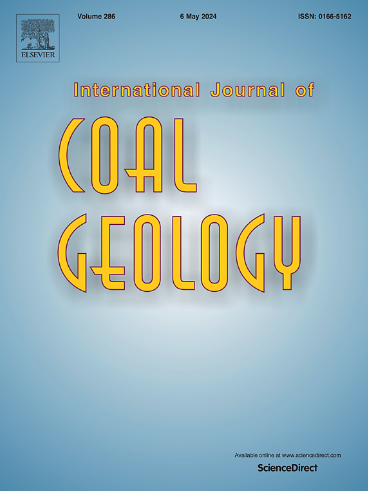Reassessment of the Pennsylvanian bio- and chronostratigraphy of the Saar-Lorraine Basin using high-precision UPb ages of volcanic ashes
IF 5.7
2区 工程技术
Q2 ENERGY & FUELS
引用次数: 0
Abstract
Chronostratigraphic calibration of the Westphalian and early Stephanian succession in the Saar-Lorraine Basin of Germany and France has been improved using high-precision U![]() Pb zircon dating of intercalated tonsteins (volcanic ashes) in coal seams. The clay mineralogy and elemental composition were determined to specify the source of these volcanic ashes and the post-depositional weathering processes. Samples selected for dating were tonsteins with homogeneous zircons without zoning to avoid the inherited ages from the volcanic chamber. Four of them provided concordant ages in agreement with their stratigraphic position. New radiometric ages constrain the hiatus below the Holz Conglomerate approximately between 307.9 and 306.0 Ma, that corresponds to the early and mid-Cantabrian substage as defined in its type area, the NW Spain. The age of T600 tonstein, which corresponds in Saar-Lorraine Basin to the Duckmantian/Bolsovian boundary is fully in agreement with ages of that boundary determined in the Ruhr Basin of the Variscan foreland and in continental basins of the Bohemian Massif. T10 tonstein on top of the Westphalian succession confirms its late Asturian age previously determined from macroflora. T00 tonstein in the Ottweiler Group provided a mid-Barruelian age, which allowed to re-define macrofloral biozones in the lower part of that group from Alethopteris zeilleri of Saberian substage to Crenulopteris lamuriana of Barruelian substage. New U
Pb zircon dating of intercalated tonsteins (volcanic ashes) in coal seams. The clay mineralogy and elemental composition were determined to specify the source of these volcanic ashes and the post-depositional weathering processes. Samples selected for dating were tonsteins with homogeneous zircons without zoning to avoid the inherited ages from the volcanic chamber. Four of them provided concordant ages in agreement with their stratigraphic position. New radiometric ages constrain the hiatus below the Holz Conglomerate approximately between 307.9 and 306.0 Ma, that corresponds to the early and mid-Cantabrian substage as defined in its type area, the NW Spain. The age of T600 tonstein, which corresponds in Saar-Lorraine Basin to the Duckmantian/Bolsovian boundary is fully in agreement with ages of that boundary determined in the Ruhr Basin of the Variscan foreland and in continental basins of the Bohemian Massif. T10 tonstein on top of the Westphalian succession confirms its late Asturian age previously determined from macroflora. T00 tonstein in the Ottweiler Group provided a mid-Barruelian age, which allowed to re-define macrofloral biozones in the lower part of that group from Alethopteris zeilleri of Saberian substage to Crenulopteris lamuriana of Barruelian substage. New U![]() Pb ages further improved correlation of local lithostratigraphic units with other basins in Europe and also with global marine-based stages. These new ages allow us to compare radioisotopically constrained Bayesian age model to metronomic age models from Bolsovian to Barruelian and show that the high frequency sequences fall in the range of the precession and obliquity. The sources of the volcanic ashes were probably volcanoes in the Vosges and Black Forest massifs. Considered could be also volcanic centers at a larger distance, e.g., the Teplice-Altenberg volcanic complex for Westphalian, Gothard and Aar massifs in Alps and the Thüringian Forest in Saxony for Stephanian and Autunian tonsteins. The detrital zircons extracted from the sandstones of the Bolsovian deposits and Holz Conglomerate (late Cantabrian) show a wide range of ages from Precambrian to Ordovician that confirms the northward source of these zircons (Rhenohercynian zone) mixed with a local source from the Mid-German Crystalline High.
Pb ages further improved correlation of local lithostratigraphic units with other basins in Europe and also with global marine-based stages. These new ages allow us to compare radioisotopically constrained Bayesian age model to metronomic age models from Bolsovian to Barruelian and show that the high frequency sequences fall in the range of the precession and obliquity. The sources of the volcanic ashes were probably volcanoes in the Vosges and Black Forest massifs. Considered could be also volcanic centers at a larger distance, e.g., the Teplice-Altenberg volcanic complex for Westphalian, Gothard and Aar massifs in Alps and the Thüringian Forest in Saxony for Stephanian and Autunian tonsteins. The detrital zircons extracted from the sandstones of the Bolsovian deposits and Holz Conglomerate (late Cantabrian) show a wide range of ages from Precambrian to Ordovician that confirms the northward source of these zircons (Rhenohercynian zone) mixed with a local source from the Mid-German Crystalline High.
利用高精度UPb火山灰年龄对萨尔-洛林盆地宾夕法尼亚生物地层和年代地层的重新评价
利用煤层中嵌套火山灰的高精度UPb锆石定年技术,改进了德国和法国萨尔-洛林盆地威斯特伐利亚和早期斯蒂芬世演替的年代地层定标。通过测定粘土矿物学和元素组成,确定了这些火山灰的来源和沉积后的风化过程。所选样品均质锆石,没有分区,以避免从火山室继承的年龄。其中4个具有与地层位置相符的年龄。新的辐射年龄限制了Holz砾岩下的间隙大约在307.9 - 306.0 Ma之间,对应于其类型区域NW西班牙定义的早-中坎塔布里亚阶段。萨尔-洛林盆地的T600 tonstein年龄对应于Duckmantian/Bolsovian边界,与Variscan前陆Ruhr盆地和波西米亚地块大陆盆地确定的该边界年龄完全一致。位于威斯特伐利亚演替序列顶端的T10 tonstein证实了之前由巨菌群确定的阿斯图里亚晚期。Ottweiler组的T00 tonstein提供了Barruelian中期的年龄,这使得该组下部从Saberian亚阶段的Alethopteris zeilleri到Barruelian亚阶段的Crenulopteris lamuriana的大花生物带重新定义。新的UPb年龄进一步改善了当地岩石地层单元与欧洲其他盆地以及全球海相的对比。这些新年龄使我们能够将放射性同位素约束的贝叶斯年龄模型与从Bolsovian到Barruelian的节拍年龄模型进行比较,并表明高频序列落在旋进和倾角范围内。火山灰的来源可能是孚日山脉和黑森林地块的火山。也可以考虑距离较远的火山中心,例如,威斯特伐利亚的Teplice-Altenberg火山群,阿尔卑斯山的Gothard和Aar地块以及萨克森州的th林根森林,Stephanian和Autunian tonstein。从Bolsovian矿床和Holz砾岩(坎塔布良晚期)的砂岩中提取的碎屑锆石显示出从前寒武纪到奥陶纪的广泛年龄范围,证实了这些锆石的北源(雷诺西西带)与中德结晶高地的局部源混合。
本文章由计算机程序翻译,如有差异,请以英文原文为准。
求助全文
约1分钟内获得全文
求助全文
来源期刊

International Journal of Coal Geology
工程技术-地球科学综合
CiteScore
11.00
自引率
14.30%
发文量
145
审稿时长
38 days
期刊介绍:
The International Journal of Coal Geology deals with fundamental and applied aspects of the geology and petrology of coal, oil/gas source rocks and shale gas resources. The journal aims to advance the exploration, exploitation and utilization of these resources, and to stimulate environmental awareness as well as advancement of engineering for effective resource management.
 求助内容:
求助内容: 应助结果提醒方式:
应助结果提醒方式:


